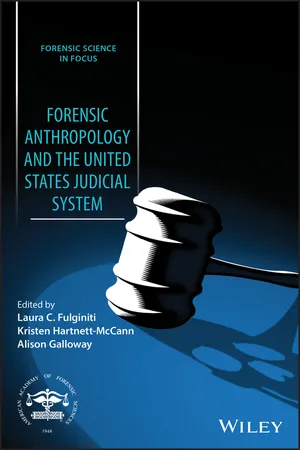
Forensic Anthropology and the United States Judicial System
- English
- ePUB (mobile friendly)
- Available on iOS & Android
Forensic Anthropology and the United States Judicial System
About This Book
A guide to the interface between forensic anthropology and the United States legal system
Designed for forensic anthropologists at all levels of expertise, Forensic Anthropology and the United States Judicial System offers a comprehensive examination of how to effectively present osteological analyses, research and interpretations in the courtroom. Written by noted experts, the book contains an historical perspective of the topic, a review of current legislation that affects expert testimony as well as vital information on courtroom procedure and judicial expectation of experts.
A comprehensive book, Forensic Anthropology and the United States Judicial System explains how to prepare case reports and offers suggestions for getting ready for pre-trial interviews. The book also includes detailed information on affidavits, fee structures and dealing with opposing experts. This book is part of the popular Wiley – American Association for Forensic Sciences series and:
- Offers a unique volume that addresses the interface between forensic anthropology and the legal system
- Contains detailed guidelines for expert testimony by forensic anthropologists with all levels of experience, from beginner to expert
- Includes information from the perspective of the Judiciary in terms of process and expectations of the Court
- Shows how to maintain independence from, and collaborate with other experts
- Presents detailed explanations of current legislation impacting forensic science
Forensic Anthropology and the United States Judicial System is an information-filled guide for practitioners of the rapidly growing field that integrates forensic sciences and the judicial system.
Frequently asked questions
Information
Part I
Context
1
Confrontation: where forensic science meets the sixth amendment
“There are few subjects, perhaps, upon which this Court and other courts have been more nearly unanimous than in their expressions of belief that the right of confrontation and cross-examination is an essential and fundamental requirement for the kind of fair trial which is this country's constitutional goal.” (Pointer v Texas, 1965, Section I, para.4).
The Confrontation Clause compels the witness “to stand face to face with the jury in order that they may look at him, and judge by his demeanor upon the stand and the manner in which he gives his testimony whether he is worthy of belief.” (Mattox v United States, 1895, Section 3, para. 4).
1.1 Sixth amendment
In all criminal prosecutions, the accused shall enjoy the right to a speedy and public trial, by an impartial jury of the State and district wherein the crime shall have been committed, which district shall have been previously ascertained by law, and to be informed of the nature and cause of the accusation; to be confronted with the witnesses against him; to have compulsory process for obtaining witnesses in his favor, and to have the Assistance of Counsel for his defense.
1.1.1 Ohio v. Roberts, 448 U.S. 56 (1980 ). Argued November 26, 1979 – decided June 23, 1980
Table of contents
- Cover
- Table of Contents
- Notes on contributors
- Preface
- Series preface
- Foreword
- Acknowledgments
- Part I: Context
- Part II: The rubber meets the road
- Index
- End User License Agreement